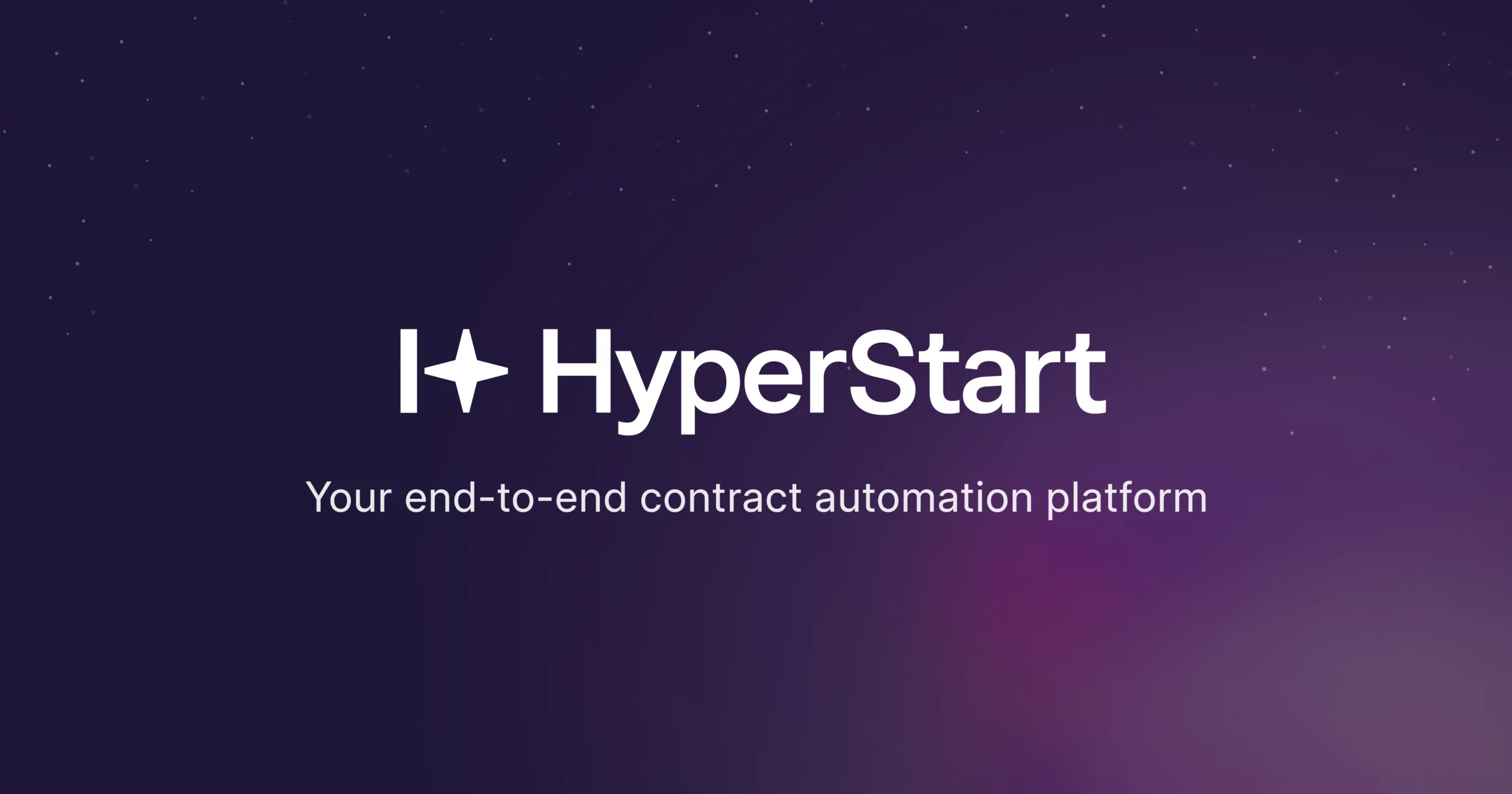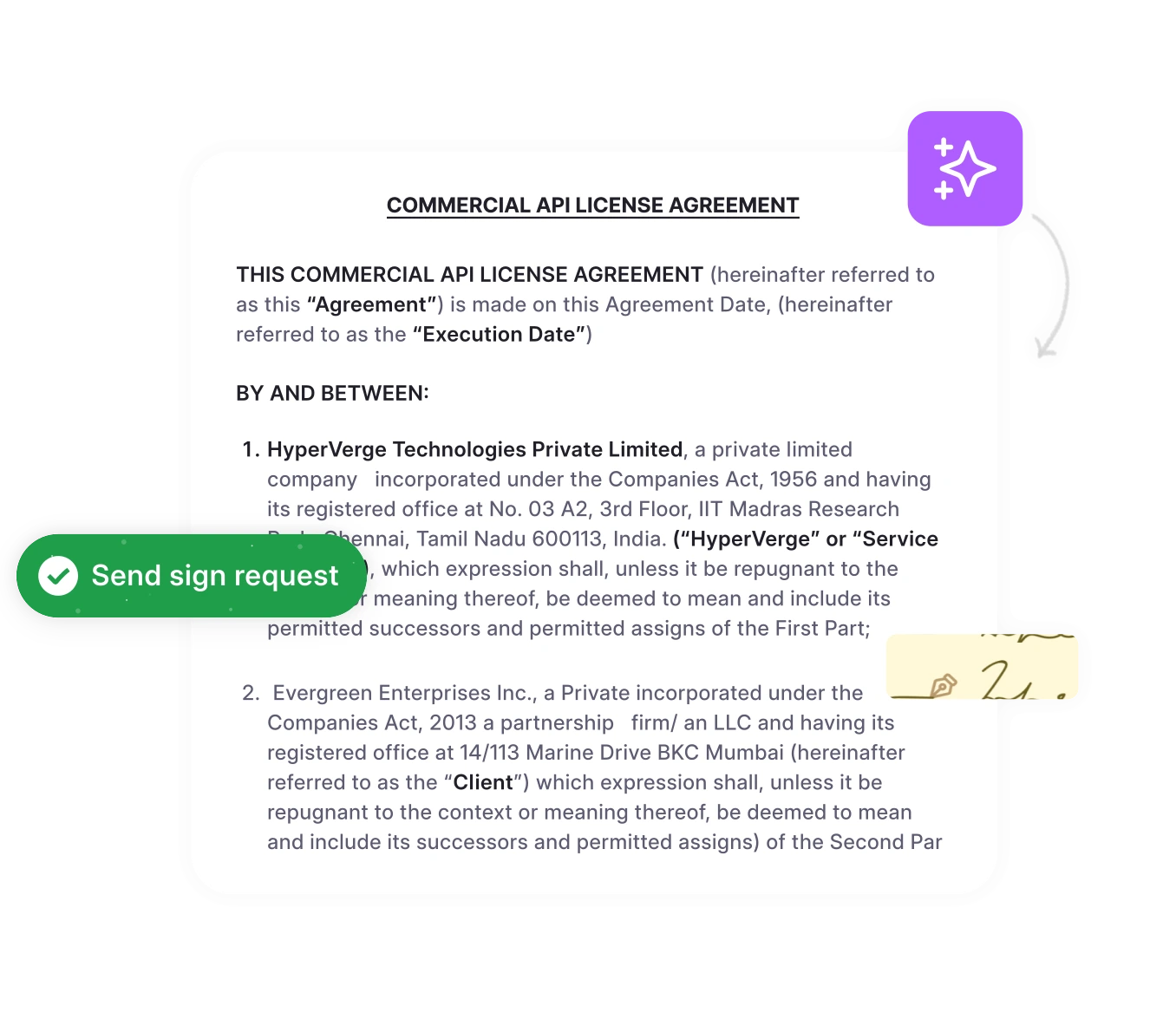Your legal team just received an invoice for a service you thought was canceled months ago. The vendor claims the contract automatically renewed under an “evergreen clause” you overlooked.
This scenario plays out in organizations everywhere. What seemed like a straightforward contract termination suddenly becomes an unexpected financial commitment because of a clause designed to keep agreements alive indefinitely.
These self-renewing agreements, known as evergreen contracts, automatically extend unless actively terminated. While they provide valuable business continuity, they can create costly surprises when renewal dates slip by unnoticed.
The challenge isn’t just knowing what evergreen clauses are. It’s knowing when they benefit your organization, how to negotiate favorable terms, and most importantly, how to track and manage them before they become expensive surprises.
This guide will explain what an evergreen contract is, its core components, and how to manage them effectively with the help of a CLM platform.
What is an evergreen contract?
An evergreen contract is a legal agreement that automatically renews after its initial term expires, continuing indefinitely until one party provides proper notice of termination. Unlike fixed-term contracts that end on a specific date, evergreen contracts “stay green” like evergreen trees. They contain automatic renewal provisions that extend the agreement successively until one party provides written notice within specified timeframes.The key characteristic that defines an evergreen contract is its automatic renewal mechanism. When the contract reaches its expiration date, instead of ending, it automatically extends for another period (typically the same length as the original term) unless one party gives notice of termination within a specified timeframe.
Common use cases for evergreen contracts include:
- Service agreements: Software subscriptions, maintenance contracts, and professional services
- Credit facilities: Lines of credit, revolving credit agreements, and loan facilities
- Supply contracts: Ongoing vendor relationships and distribution agreements
- Employment contracts: Executive agreements and consulting arrangements
- Licensing agreements: Software licenses, intellectual property rights, and franchise agreements
Now that we have understood what an evergreen contract is, let’s take a closer look at the key elements that make up these agreements.
What are the core elements of evergreen contracts?
Every evergreen contract contains these essential components:
- Initial Term: The original contract period, typically ranging from one month to several years. This establishes the baseline duration for all subsequent renewals.
- Automatic Renewal Clause: The contractual language that triggers the renewal. For example: This agreement shall have an automatic renewal clause for successive one-year periods unless either party provides written notice of termination at least 30 days before the expiration date.
- Notice Requirements: Specific conditions for termination, including the required notice period (30, 60, or 90 days is common), delivery method (written notice, certified mail, or email), and who must receive the notice.
- Renewal Terms: Whether the renewed contract maintains the same terms or allows for modifications such as price adjustments or updated service levels.
With the core elements of evergreen contracts in mind, it’s also important to consider the potential risks and challenges that may arise with these agreements.
Perpetual contracts are indefinite agreements with no built-in renewal mechanism or termination procedures, essentially lasting forever unless specific events trigger termination. These contracts face significant legal challenges—states like Illinois have ruled that perpetual contracts violate public policy and are therefore unenforceable, while California and New York evaluate them case-by-case.
Evergreen contracts, by contrast, operate on fixed terms that automatically renew for specified periods (monthly, annually, etc.) with clear termination procedures and notice requirements. They’re widely accepted across all U.S. jurisdictions and offer more flexibility, allowing for term modifications at each renewal period.
The key difference: Evergreen contracts provide the continuity benefits of ongoing relationships while maintaining legal enforceability and operational flexibility that true perpetual contracts cannot offer. This is why modern businesses favor evergreen structures over perpetual arrangements.
Regain control over auto-renewal risk
HyperStart analyzes evergreen clauses and renewal triggers to help you identify hidden obligations before they bind you long-term.
Book a DemoPerceived challenges of evergreen contracts debunked
Resistance to evergreen contracts is usually because of pre-conceived notions about contract terms. On the contrary, evergreen contracts that are well drafted and structured serve both parties with both stability and flexibility.
Here is a list of 5 misconceived challenges of evergreen contracts debunked.
1. Lack of contract visibility
Challenge: Without centralized visibility into their evergreen contract portfolio, organizations operate blindly. Teams can’t identify which contracts need renegotiation, when key terms are triggered, or which agreements are underperforming. This lack of oversight leads to missed cost savings, compliance gaps, and reactive decision-making. When problems finally surface, they’ve often compounded across multiple contracts, making resolution more complex and expensive.
Some jurisdictions restrict automatic renewal (evergreen) clauses, especially in consumer contracts, leases, and labor agreements, so local laws must be checked.
For example, in Judson Roberts Company v. Seaboard Allied Milling Corporation, the Missouri court upheld a contract’s automatic one-year renewal because the defendant failed to give written notice by registered mail at least sixty days before the anniversary date.
Evergreen clauses require timely written notice to avoid automatic renewal; otherwise, contracts renew as agreed. Careful attention to legal requirements helps prevent unintended renewals or disputes.
— James P. Maloney, Baker Sterchi
Solution: Implement a centralized contract management system that provides real-time visibility into your entire evergreen portfolio. Use automated alerts for key dates and performance metrics, and establish regular contract reviews to identify optimization opportunities before they become costly problems.
2. Missed termination windows and financial exposure
Challenge: Narrow termination notice windows (30-90 days) can trap organizations in unwanted commitments when budget cuts or strategic changes occur with shorter notice periods. Missing these deadlines can result in unwanted financial commitments for the entire additional contract terms, potentially costing organizations hundreds of thousands of dollars.
Solution: Set up automated alerts 120+ days before renewal dates and maintain termination calendars with multiple stakeholder notifications. Price protection with fair rate adjustments, explicit rights explaining benefits and protections.
When providers engage in good faith negotiations that continue past the date by which a termination notice is needed. Example: “[T]his Agreement shall…automatically renew for each subsequent renewal term….”
Automated renewal tracking can help you focus on payer contract renegotiations well in advance. You have time to secure reimbursement rate increases incrementally instead of trying to make up for lost opportunities.
3. Limited renegotiation leverage
Challenge: Automatic renewals reduce negotiating leverage as vendors have less incentive to offer improved terms or match competitive pricing. Organizations lose the natural pressure point that comes with contract expiration, making it difficult to secure better rates, enhanced service levels, or updated terms that reflect current market conditions.
An astonishing 60% of all supplier contracts automatically renew without the knowledge of the buyer, simply because the buyer fails to give notice of termination. Fifty percent (50%) self-renew on more than one occasion.
Solution: Schedule periodic market benchmarking and proactive renegotiation discussions before automatic renewal periods to maintain competitive positioning. Build renegotiation rights into evergreen contracts at specified intervals.
4. Being locked into services indefinitely and inflexibly
Challenge: Evergreen contracts can trap organizations in rigid service arrangements that no longer meet evolving business needs. Without clear termination clauses, companies may find themselves paying for outdated services, underperforming vendors, or solutions that no longer align with strategic objectives. This inflexibility becomes particularly problematic during business pivots or when superior alternatives emerge.
Solution: Build in periodic review periods with options to modify or terminate services. Include performance-based exit clauses and ensure reasonable notice periods for contract termination. Negotiate flexibility provisions that allow for service adjustments based on changing business requirements or performance standards.
Five states—California, Florida, Illinois, Michigan, and New York—have established specific statutory frameworks governing automatic renewal provisions, while the remaining 45 states rely on general contract law principles for enforcement.
California’s regulatory approach focuses on disclosure requirements for subscription services, mandating that evergreen clauses appear in “clear and conspicuous” format with enhanced typography specifications, including larger font size and contrasting colors to ensure visibility.
Illinois enacted the Automatic Contract Renewal Act, which requires organizations to prominently display automatic renewal language within contract terms and specify cancellation procedures. For agreements exceeding twelve months, the statute mandates written consumer notification before renewal activation, creating additional compliance obligations for contract administrators.
Compliance Consideration: Organizations operating across multiple jurisdictions must navigate varying disclosure requirements and notification standards, making standardized contract management processes essential for regulatory compliance.
Review evergreen clauses with long-term clarity
HyperStart highlights vague renewal language, outdated SLAs, and missing review triggers—so your contracts stay relevant and enforceable.
Book a DemoWhile it’s crucial to be aware of the risks and challenges that evergreen contracts may introduce, it’s equally important to recognize the significant benefits these agreements can offer organizations.
What are the benefits of evergreen contracts for organizations?
Evergreen contracts provide organizations with a foundation for ongoing business relationships, promoting continuity and stability without the need for frequent renegotiations. But only when appropriately managed.
Here are the 5 key benefits of evergreen contracts as mentioned below:
1. Maintain business continuity without interruptions
Critical business services continue seamlessly without administrative gaps that could impact operations. Unlike fixed-term contracts that create natural break points, evergreen agreements ensure essential functions keep running regardless of busy periods or staff changes.
Consider a hospital system that relies on evergreen contracts for medical equipment maintenance. During a major expansion project when legal resources were stretched thin, these agreements ensured life-saving equipment remained properly serviced without requiring immediate attention from overloaded legal teams.
2. Reduce contract administration workload significantly
Legal teams face a substantial administrative burden during renewal processes, including stakeholder consultations, negotiations, and approvals. For organizations managing hundreds of vendor relationships, this translates to thousands of hours annually that could be better spent on strategic initiatives.
Evergreen contracts eliminate this repetitive work for stable, ongoing relationships. Instead of managing routine renewals, legal professionals can focus on complex contract negotiations, compliance initiatives, and business development support that drive organizational growth.
3. Gain predictable costs for better budget planning
Finance teams can project expenses confidently, knowing that key operational costs will continue under established terms. This visibility enables better cash flow management and strategic resource allocation decisions, especially valuable during volatile business periods.
Evergreen contracts often include graduated pricing schedules that provide cost certainty even when prices increase. Rather than facing unpredictable market-rate adjustments during renewal negotiations, organizations know exactly how their costs will evolve over time.
4. Strengthen vendor relationships and unlock partnership value
Evergreen contracts signal organizational commitment to long-term partnerships, often resulting in preferential treatment and enhanced service levels. Vendors invest more in relationships when they have guaranteed long-term business, providing priority support and better resource allocation.
The partnership value extends to innovation collaboration. Vendors are more likely to involve evergreen customers in beta testing programs, early feature access, and co-development opportunities that provide competitive advantages unavailable through shorter-term arrangements.
5. Eliminate coverage gaps and reduce legal risk
Well-structured, evergreen contracts can reduce organizational risk by eliminating vulnerability periods between contract terms. Coverage gaps expose organizations to liability risks, service interruptions, or emergency procurement situations with unfavorable terms.
Established evergreen relationships also involve proven processes and tested escalation procedures. When disputes arise, both parties understand how to resolve issues efficiently rather than starting from scratch with new vendors.
Having explored the benefits that evergreen contracts offer organizations, it’s also essential to understand how these agreements can be ended when necessary.
Don’t let silent renewals become financial liabilities
HyperStart identifies auto-renewal risks, missed escalation triggers, and unenforceable clauses before the contract rolls over.
Book a DemoHow to terminate an evergreen contract in 4 steps
Understanding termination procedures is crucial for managing evergreen contracts effectively.
Here’s a comprehensive 4-step framework for legal professionals.
Step 1: Review contract terms and notice requirements
Before initiating termination, identify key elements: notice period (30, 60, 90 days), required delivery method, specific recipient, termination timing restrictions, and any cure periods for the other party.
Step 2: Draft professional termination notice
Include contract identification, a clear termination statement, a legal basis citing the specific clause, an effective date, and transition requirements.
Step 3: Ensure proper delivery and documentation
Follow contract specifications exactly, use multiple delivery methods when possible, obtain delivery confirmation, and document all details, including dates and recipients.
Step 4: Manage the transition period
Monitor ongoing obligations, prepare for service transition, handle final payments, secure data return, and document any disputes during the notice period.
For convenience: Termination without cause with advance notice.
For cause: Immediate termination due to contract breaches.
Mutual agreement: Both parties negotiate separation terms.
Automatic: Triggered by specific events like bankruptcy or regulatory changes.
After understanding how to terminate an evergreen contract, it’s helpful to see how CLM software can simplify managing these agreements.
How to manage evergreen contracts with CLM software
Effective evergreen contract management requires systematic processes and intelligent technology tools. Modern contract lifecycle management software addresses the core challenges through automated tracking and comprehensive oversight.
1. Automated renewal tracking
Evergreen contracts with automated renewals can pass unnoticed. HyperStart automatically flags evergreen clauses and creates dynamic alert schedules with stakeholder-specific routing and mobile notifications, preventing costly surprise renewals.
2. Centralized contract intelligence
Modern CLM systems create a single source of truth, preventing contracts from hiding in forgotten file systems. Advanced search capabilities and visual contract maps showing relationship dependencies eliminate the “forgotten contract” problem that plagues scattered storage systems.
3. Performance monitoring and analytics
Real-time contract performance monitoring identifies underperforming evergreen relationships for potential termination. HyperStart provides vendor scorecards tracking delivery, quality, and compliance metrics alongside cost analysis. AI-powered analytics help legal teams make informed renewal decisions based on performance history and business needs.
4. Workflow automation
Automated workflows ensure consistent renewal processes with appropriate workflow approvals. HyperStart’s workflow features include streamlined approval routing, decision documentation, and reminder notifications, transforming management from reactive crisis response to proactive strategic governance.












